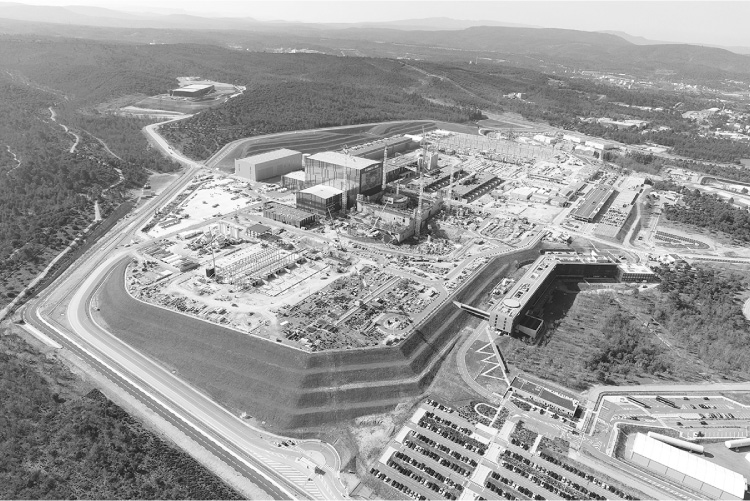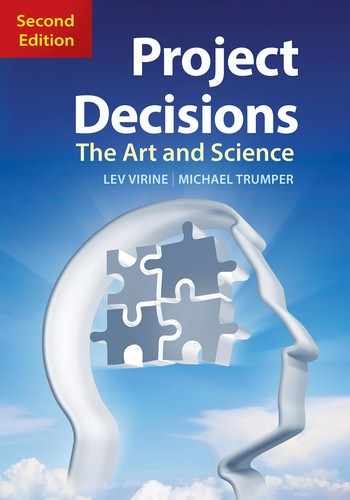CONCLUSION
Does Decision Analysis Provide a Solution?
“It is our choices, Harry, that show what we truly are, far more than our abilities.”
—DUMBLEDORE TO HARRY POTTER IN J. K. ROWLING’S HARRY POTTER AND THE CHAMBER OF SECRETS
In this book we reviewed the multiple aspects of the formalized decision analysis process and its application in project management. Experience of various projects in different industries where decision analysis was used demonstrates its efficiency and usefulness. It is always cheaper to perform analysis—including decision analysis—in advance, rather than having to fix problems when the project has started. Still, there are a number of misconceptions related to the decision analysis process.
Common Misconceptions about Decision Analysis
MISCONCEPTION 1: THE DECISION ANALYSIS PROCESS IS NOT BENEFICIAL BECAUSE IT CANNOT ENSURE PROJECT SUCCESS
Failure of a project is simply not an indication that the decision analysis process did not work. As described at the start of this book, both NASA and Lockheed Martin took calculated risks and invested in new, unproven technologies. Without taking any risks at all, the research and development would have been impossible. To mitigate some of the risks, NASA and Lockheed Martin built a cheaper test vehicle instead of a full-scale spacecraft. In cases like this, decision analysis can help reduce the number of irrational project decisions and can significantly mitigate their negative outcomes.
MISCONCEPTION 2: DECISION ANALYSIS ADDS ADDITIONAL LEVELS OF BUREAUCRACY
Absolutely anything can devolve into a bureaucratic procedure. For example, when you go to the supermarket, you put your groceries on the conveyor belt and give the cashier your credit card, followed by the store’s loyalty card, cards from affiliated loyalty programs, perhaps a gift certificate, coupons from the store, and so on. You get the picture. In return, the cashier gives you a receipt, your credit card receipt, and some coupons. In addition, you collect 30 coupons that will give you a 5% discount on various items on your next shopping trip. What used to be a quick exchange of goods for cash is now a web of mind-boggling transactions.
Organizations should use a decision analysis process, provided that everyone feels it is helpful. If the process creates extra delay or introduces a paperwork burden, scrap it immediately.
Decision analysis does not necessarily imply additional administrative overhead. It is more a way of thinking than a documentation management process, and it should be made as simple as possible. We have stressed throughout the book that a decision analysis process can be tailored to meet specific organizational needs. For example, if you do not think that quantitative analysis is going to add any benefit to your project, no problem—don’t use it.
Remember that the main purposes of decision analysis are to:
• Come up with real alternatives
• Analyze which alternative will bring the most value
• Select a course of action and monitor its progress (most organizations already do this in one way or another)
Organizations spend huge amounts of resources establishing business processes, usually for business software, training, consulting, and such. And in most cases, that is a good investment for the right causes. Sometimes such processes do not work as planned and do, in fact, create a bureaucracy that leads to more spending. If this occurs, it is important to freeze the implementation and make necessary adjustments; or if things are really dire, scrap the process altogether. It is like an investment in the stock market: if you see a stock tumbling, don’t wait until it hits bottom. Sell it now and limit your losses.
MISCONCEPTION 3: ONLY ORGANIZATIONS WITH MATURE PROJECT MANAGEMENT PROCESSES CAN BENEFIT FROM DECISION ANALYSIS
Any company should be able to benefit from the decision analysis process in the same way that any person would benefit from knowing how to think rationally. For example, if you have received a bonus at work, you probably have a few options:
A. Pay down your mortgage (apparently, this is not a very popular alternative).
B. Buy 10 new pairs of shoes from Oscar de la Renta.
C. Gamble everything at the local casino.
You will select an alternative based on your preferences (your risk profile) and on which one will give you maximum value. The point is that you do not need to hire a consultant, create a sophisticated mathematical model, and produce a large amount of paperwork to make this decision. The only thing you need to do is make a logical, rational choice based on the alternatives, perhaps using something that you have learned from this book.
If you want to establish a decision analysis process, do it step-by-step. For example, start by identifying your success criteria, which should be consistent over multiple projects, and then specify who will evaluate the alternatives. If you feel that you are benefiting from these activities, you may continue adding additional stages of the process: modeling, quantitative analysis, and review. Once you are comfortable and even happy with your process, you may then want to invest in a software system that will help you with your project decision analysis.
Why Do We Believe that the Decision Analysis Process Is So Important?
The age of amateur tinkers working away in their garages and developing state-of-the-art technology has passed. Technical innovations in our modern world have become extremely expensive and take a much longer time to develop. But marshaling all the money, engineers, and managers still does not ensure success. Here are just several examples:
• After the first satellite launch in 1957 and the first manned space flight in 1961, people started dreaming about building cities on the Moon and Mars. Well, we all know how far we have gotten with that effort! Despite having flown to the moon and back, humanity has not made any more significant strides in human space exploration. This is certainly not what was prognosticated in the early excitement of the 1960s. In reality, the design of SpaceX and other new generations of launch vehicles that promise to replace the old Space Shuttle is conceptually very similar to what we had over 60 years ago.
• For several decades people have been trying to build a thermonuclear reactor to produce electric power using fusion. Despite significant progress in the research, a working fusion reactor remains a distant dream. The international community, including the European Union, Japan, China, Russia, the Republic of Korea, and the United States, were originally planning to invest $5 billion over next 10 years in the ITER project (ITER 2018), an experiment aimed at proving that fusion can be used to generate electric power). In June 2005 this group decided that a 500 megawatt reactor would be built at Cadarache, in the south of France, with the first plasma ITER reactors planned to be online at the end of 2016. Cost estimates made in 2015 were approximately $15 billion, and today the first plasma reactor is expected to be operating in 2025.

Figure Conci. Aerial View of ITER Site in 2018 (Credit: Oak Ridge National Laboratory, 2018)
Often, when engineers are unable to solve a technical problem, they say that the technology is “not mature.” What does that mean? It means that they have not spent enough time and resources to solve the problem.
Because we global citizens, wherever we live, are always faced with scarce resources, where can we find the additional ways to solve these problems? Perhaps the solution to scarce resources lies in a more efficient use of the resources we do have. One way to do that is to use data analysis, along with better management practices. Decision analysis is one of such technologies. In particular:
• Good decision analysis processes can reduce the burden of wrong decisions and allow us to spend resources more efficiently, and also to improve organizational performance.
• Changes in corporate culture and the elimination of FES (Frustrated Employee Syndrome) will reduce the inefficient allocation of resources and increase productivity.
In conclusion, while resources will always be limited, we exacerbate resource scarcity through poor decision-making. If decision-makers throughout business and government can learn and practice proper decision analysis processes, that alone will lead to a major acceleration in technological innovation and productivity.
